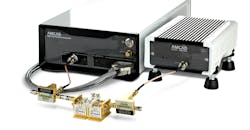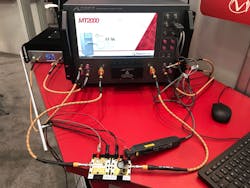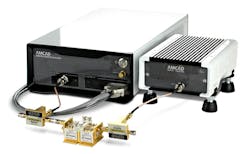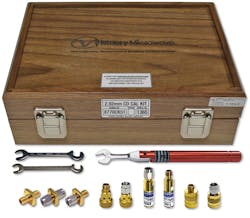Long-Standing Company Reveals Many New Tricks at IMS
Anyone involved with RF/microwave device characterization is likely to be familiar with Maury Microwave, one of the venerable companies in the RF/microwave industry. With a history that dates to 1957, the company is a well-known provider of device characterization solutions along with both precision calibration and interconnect products. While Maury Microwave might be considered “old” in terms of age, the company presented some new “tricks” at the recent IMS 2019.
One of the company’s focal points at IMS was its MT2000 Series of mixed-signal active load-pull systems, which was recently updated (Fig. 1). The MT2000 systems now deliver 1,000 MHz of wideband impedance control for 5G and Wi-Fi device characterization.
1. On display at IMS 2019 were the MT2000 Series mixed-signal active load-pull systems, which now provide 1,000 MHz of wideband impedance control.
These systems are essentially a turnkey solution—one MT2000 can replace multiple instruments used in counterpart test systems, including a vector network analyzer (VNA), vector signal analyzer (VSA), oscilloscope, modulated signal sources, and automated impedance tuners. Maury Microwave claims that the MT2000 Series is “the only commercial load-pull solution suitable for 5G measurements” and that it “overcomes the well-known limitations of passive load-pull and automated impedance tuners.”
The MT2000 solutions can perform load pull at speeds as high as 1,000 impedance/power states per minute under specified conditions. They cover a frequency range from 1 MHz to 40 GHz. The MT2000 systems are intended for research and development, design verification test (DVT), and production test environments.
Maury Microwave also recently launched the AM3100 pulsed source-measure-unit (SMU) system in partnership with AMCAD Engineering (Fig. 2). The AM3100 is a standalone pulsed IV system for load-pull and general-purpose test applications. It can be used to bias transistors or circuits in pulsed conditions to avoid self-heating and ensure quasi-isothermal conditions during measurements.
2. The AM3100 system can be used to pulse the bias of power amplifiers.
The AM3100 consists of the AM3103 control unit and AM3121 drain pulse SMU. Inside the AM3103 box is the AM3111 gate pulse SMU, which is a four-quadrant dc or pulsed-voltage source. The AM3111 has a voltage range of ±25 V and provides two current ranges: ±5 and ±200 mA. Pulse widths can be as low as 1 µs.
The AM3121 power probe is dedicated to biasing transistor drains. It’s optimized for high-power-pulsed measurement applications—specifically, the AM3121 is rated for voltages as high as 120 V and pulsed currents as high as 30 A. The AM3121 can be used either for load-pull applications or as a general-purpose pulsed SMU.
Other key attributes of the AM3100 are internal and external synchronization and triggering. The system can be controlled through direct SCPI commands via USB or Ethernet. In addition, the AM3100 features multiple levels of embedded protection circuitry that includes a fast short-circuit current breaker (electronic fuse). On top of that, the AM3100 is a highly integrated solution—a single AM3100 can replace multiple instruments in corresponding test setups like power supplies, multimeters, and an oscilloscope.
Calibration Tools Get the Spotlight
Maury Microwave also made some new updates to its portfolio of calibration products. For example, the company unleashed its Insight software platform, which Maury boasts “is the industry’s first commercial software suite designed to empower VNA users and help them make better decisions.” The firm also maintains that “Insight represents a paradigm shift in the way users approach VNA calibration, validation, measurement, visualization, and analysis.”
Maury obviously has some high words for the Insight software platform, but what exactly does it offer? Foremost, Insight is a single software platform that can be used with most commercial VNAs. One feature is that it enables users to define mechanical calibration standards from any vendor, which can then be used with all VNAs.
The company also says that Insight makes it possible to avoid common errors thanks to a simplified calibration process driven by an intuitive graphical user interface (GUI) and wizard. Users can validate VNA calibration using airlines and individually characterized verification kits. In addition, S-parameters can be measured and S2P files can be saved for sharing. Additional features include advanced visualization and analysis tools that allow for a better understanding of the measurement results.
The “tricks” don’t stop there, though. Maury Microwave also revealed its CK50 Series characterized device (CD) calibration kits, which consist of individually characterized short, open, and fixed-load standards (Fig. 3). Each kit comes with custom S-parameter files that are used for VNA calibration instead of a generalized polynomial definition. The result, according to Maury, is the accuracy of thru-reflect-line (TRL) calibrations combined with the ease of use of fixed-load short-open-load-thru (SOLT) calibrations.
3. The CK50 Series calibration kits leverage individually characterized calibration standards.
Lastly, the new CK60 Series verification kits are intended to allow users to validate one- and two-port VNA calibration for well-matched and mismatched devices under test (DUTs). Replete with individually characterized verification standards (short, load, airline, mismatch airline), each kit is used to validate calibrations by comparing the S-parameters of the individual verification standards measured by the user with the S-parameters measured at the factory.
The CK50 Series calibration kits, CK60 Series verification kits, and Insight software can be used in combination. When utilized in tandem, users are able to quantify the uncertainty contribution of the calibration kit with respect to the overall measurement uncertainty and employ overlapping uncertainty boundaries to validate a VNA calibration with increased confidence.




